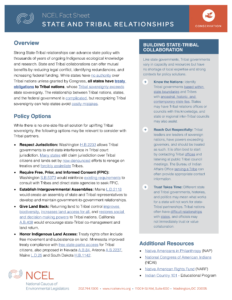New Partnership Fosters Relationships Between States and Tribes for the Environment
New Partnership Fosters Relationships Between States and Tribes for the Environment
We are at an inflection point in state and Tribal relations. While Tribal communities have long understood that their conservation efforts are affected by state policy decisions, in recent years many state legislators have begun to realize that they will not be able to achieve their environmental goals without the support and knowledge of Indigenous and Tribal communities. In the struggle for clean air and water, Tribal Nations are both sovereign entities and symbiotic partners.
Despite this recognition, until recently there was scant support for including Indigenous voices in discussions shaping our shared future, and scarce resources for meaningful co-management of public lands. That changed with last year’s passage of the groundbreaking Bipartisan Infrastructure Law, which made significant investments in Tribal Nations, and the Inflation Reduction Act, which earmarked nearly $14 billion to Tribal conservation and infrastructure projects. States can also be helpful advocates in ensuring Tribal access to funding.
Click here to access the NCEL State and Tribal Relationships Fact Sheet
With these and other recent developments (like President Biden’s America the Beautiful plan, which aims to preserve 30 percent of America’s lands and waters by 2030), many of the historic barriers to Tribe-State collaboration have begun to recede—and none too soon if we want to preserve our natural resources. But a major one remains: the lack of knowledge that many state elected officials have about Tribes and the role they can play in an effective environmental movement.
A new partnership between the National Caucus of Environmental Legislators (NCEL) and Native Americans in Philanthropy (NAP) seeks to change that. Drawing on our expansive combined networks of state lawmakers, Tribal leaders, private philanthropy, Native nonprofits, and federal and state funders, the partnership plans to convene a series of educational events that clarify the unique contours of the State-Tribal relationship, explore its history, and identify opportunities for states to partner with philanthropy to support Tribal climate and conservation efforts—and vice versa.
The NAP-NCEL partnership was founded with the understanding that Native wisdom, in conjunction with support from state leaders, is pivotal in protecting our land, water, air, and wildlife. Our shared conservation goals simply cannot be met without Tribal leadership.
This is a welcome and long-overdue shift in thinking. Across the country, Tribes and state officials are working to create solutions to complex environmental issues by incorporating Native communities’ traditional ecological knowledge into decision-making and honoring Tribal Nations as the original stewards of the land that is today the United States. They’re demonstrating that Tribal partners can help state and federal officials better manage public lands and public resources.
For example, the Minnesota Historical Society returned over 100 acres of land along the Minnesota River to the Lower Sioux Indian Community last February. The Lower Sioux tribe has sought to reclaim this land for over 20 years, and four years after the state legislature approved the transfer, the tribes are now able to manage, restore, and protect the land. This transfer is the beginning of deeper conversations around returning sacred land back to Tribal control and management.
Thanks to the role of private philanthropy and public-private partnerships, Tribes bring more than sovereignty and know-how to the conversation. The government and the private sector have a long history of working together to achieve shared goals and leverage resources for maximum impact, and now, under the incentives built into grant programs like the America the Beautiful Challenge and the Inflation Reduction Act, Native communities have been explicitly brought into that framework: these programs’ impact on land, water, and wildlife can be doubled if states and Tribes work together.
NAP has already demonstrated how philanthropic and government resources can be deployed to maximize public investment in Tribal communities. Last year, it worked with the National Fish and Wildlife Foundation to provide non-federal match support for Tribal applicants, which unlocked $26.7 million in federal funding to support conservation efforts at 14 different Tribal Nations. By leveraging similar collaborations on the state level, we can further advance environmental initiatives led by Tribal Nations in a collaborative, sustainable, and respectful way.
The NAP-NCEL partnership is designed to ensure that state environmental efforts, including public-private partnerships, work with Tribes rather than around them. Past efforts to exclude Tribes from the decision-making process have led to disastrous outcomes. And with the average global temperature recently reaching an all-time high, the impacts of climate change are becoming increasingly apparent across the country.
Tribally-led conservation work is critical, whether the challenge is to prevent catastrophic wildfires, to develop and place renewable energy projects, or to actually conserve 30 percent of our land and water resources in the next seven years. Thanks to the new NAP-NCEL partnership, more state lawmakers will understand how—and why— to collaborate with Tribal Nations.






Comments